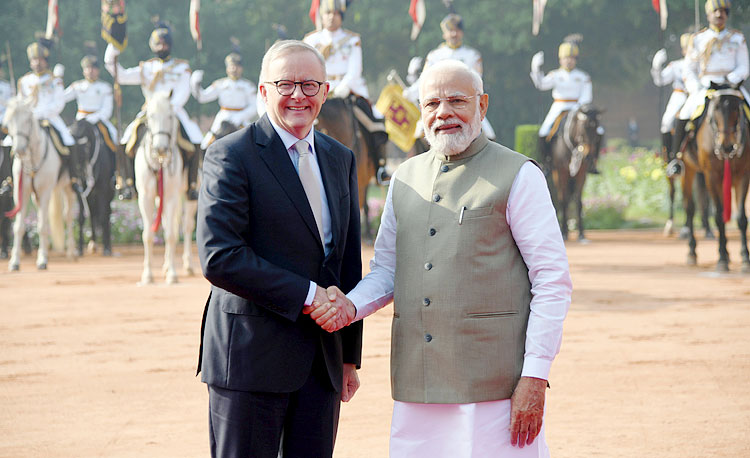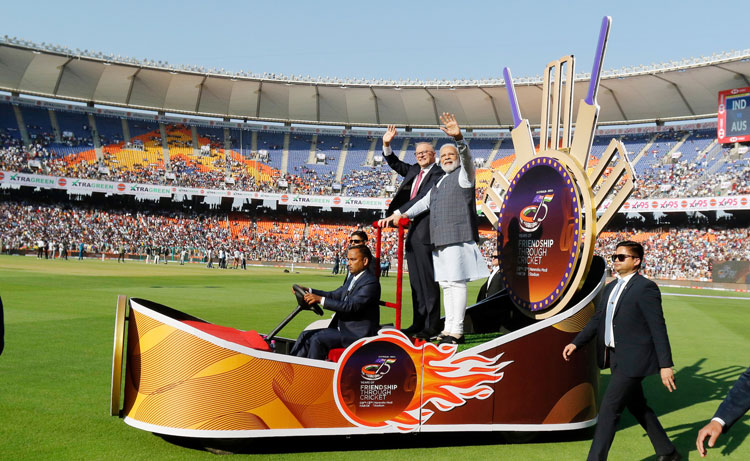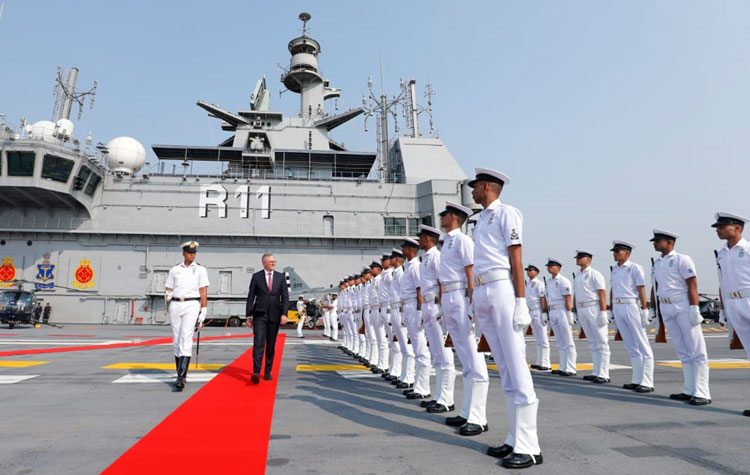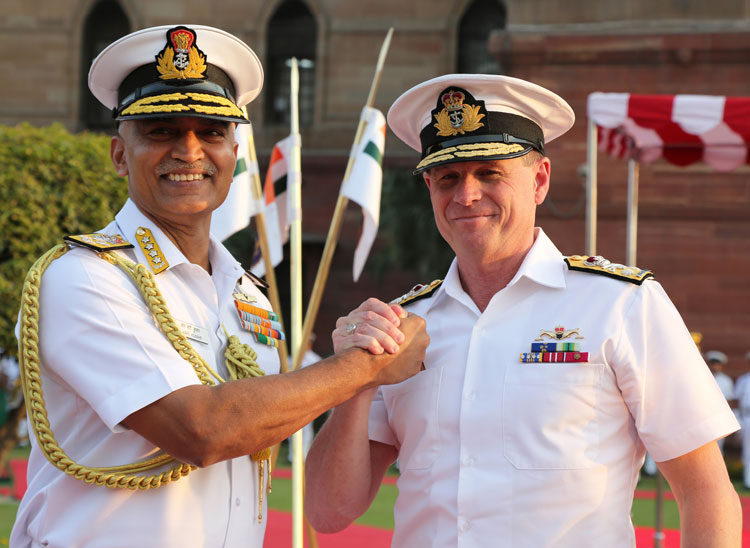INDIAN ARMED FORCES CHIEFS ON OUR RELENTLESS AND FOCUSED PUBLISHING EFFORTS

The insightful articles, inspiring narrations and analytical perspectives presented by the Editorial Team, establish an alluring connect with the reader. My compliments and best wishes to SP Guide Publications.

"Over the past 60 years, the growth of SP Guide Publications has mirrored the rising stature of Indian Navy. Its well-researched and informative magazines on Defence and Aerospace sector have served to shape an educated opinion of our military personnel, policy makers and the public alike. I wish SP's Publication team continued success, fair winds and following seas in all future endeavour!"

Since, its inception in 1964, SP Guide Publications has consistently demonstrated commitment to high-quality journalism in the aerospace and defence sectors, earning a well-deserved reputation as Asia's largest media house in this domain. I wish SP Guide Publications continued success in its pursuit of excellence.
- A leap in Indian aviation: Prime Minister Modi inaugurates Safran's Global MRO Hub in Hyderabad, Calls It a Milestone
- All about HAMMER Smart Precision Guided Weapon in India — “BEL-Safran Collaboration”
- India, Germany deepen defence ties as High Defence Committee charts ambitious plan
- True strategic autonomy will come only when our code is as indigenous as our hardware: Rajnath Singh
- EXCLUSIVE: Manish Kumar Jha speaks with Air Marshal Ashutosh Dixit, Chief of Integrated Defence Staff (CISC) at Headquarters, Integrated Defence Staff (IDS)
- Experts Speak: G20 Summit: A Sign of Global Fracture
India-Australia: In Top Gear
Relationship between the two countries has evolved to the level of comprehensive strategic partnership in June 2020, from strategic partnership agreement in 2009

It was not a mere coincidence that when the Australian Prime Minister Anthony Albanese was visiting India from March 8-11, the Indian Defence Minister Rajnath Singh had a telephonic conversation with Deputy Prime Minister and Minister of Defence Richard Marles on March 09 and the Australian Naval Chief Vice Admiral Mark Hammond landed in New Delhi on the same day for expanding bilateral naval partnership. This coordinated interaction at various levels between two QUAD partners, which drew attention of the strategic arena world over, was supportive evidence of Prime Minister Albanese widely quoted statement on the decks of INS Vikrant, India's gigantic indigenously built Aircraft Carrier, "India is a top tier -security partner". India's growing heft in Indo-Pacific and widening rift in Australia-China relations along with India's perceived rise as an economic power providing a huge market for developed world has perhaps brought Australia closer to India. The relationship witnessed an upsurge in last few years, which evolved to the level of comprehensive strategic partnership in June 2020, from strategic partnership agreement in 2009.
Following the agreement in 2014 of a bilateral framework for security cooperation, the defence relationship has grown to include a range of forums for strategic dialogue, as well as regular interactions
Though the seeds of India-Australia diplomatic relations were sown in 1945, at the fag end of the British era, with the opening of High Commissions in each other capitals, the two countries remained mired in cold war dynamics, which prevented the relationship to grow beyond Curry, Cricket and Commonwealth. Infact, the relations got soured in 1998 when Australia sanctioned India after the Pokaran nuclear tests. However, as the world realised the strategic significance of India's nuclear explosion, Australian leaders also started opening to India with defence exchanges. The warships of two countries started exercising together since 2015 though Australia was invited for the first five nation multilateral Malabar naval exercise in the Bay of Bengal in 2007. Positive turn in relationship between India and Australia began almost two decades ago overcoming the 1998 nuclear related sanctions on India. The two nations signed a memorandum on defence cooperation in 2006 and later in 2009 a joint declaration on security cooperation was released. Following the agreement in 2014 of a bilateral framework for security cooperation, the defence relationship has grown to include a range of forums for strategic dialogue, as well as regular interactions through senior visits, staff talks and training exchanges.

The depth of this deepening strategic partnership can be understood from the fact that the two nations have not only decided to have annual summit level meetings, but also 2+2 dialogue involving defence and foreign ministers of both countries. India holds such high level dialogue only with US and Japan. The other institutional dialogue mechanisms consists of foreign ministers framework dialogue, joint trade and commerce ministerial commission, defence policy talks, Australia India education council, defence services staff talks, energy dialogue, India – Australia - Japan trilateral dialogue, India - Australia – Indonesia trilateral dialogue, India - France - Australia trilateral dialogue, India Australia bilateral dialogue on global cyber issues, India Australia maritime dialogue, India Australia bilateral economic policy dialogue, India Australia dialogue on disarmament, non-proliferation and export control as well as joint working group on counter terrorism etc has brought two countries together as a partner in safeguarding not only each other's national interests but also ensuring peace and stability from Indian Ocean to South China Sea. Albanese very aptly remarked, "My visit reflects my government's commitment to place India at the heart of Australia's approach to the Indo-Pacific and beyond." Similarly, while detailing the telephonic conversation between Indian defence minister Rajnath Singh and his Australian counterpart, a defence ministry spokesperson quoted Rajnath Singh as saying "The telecon was reflective of the trust and friendship the two countries share especially in matters related to defence and security."
The two countries also agreed to permit conduct of aircraft deployments from each other's territories to build operational familiarity and enhance maritime domain awareness
Growing strategic proximity between India and Australia was visible during Prime Minister Albanese visit when he and Prime Minister Narendra Modi publicly displayed their bonhomie in the cricket stadium of Ahmedabad during India Australia fourth test match. After the talks the two leaders issued a joint statement reflecting their commitment to together work for ensuring respect of rule of law in international waters. In the joint statement issued after the conclusion of the visit, the two leaders described the defence and security cooperation as the main pillar of India Australia comprehensive strategic partnership, and expressed their unwavering commitment to strengthening the defence and security partnership to address shared challenges and work towards an open, inclusive and prosperous Indo-pacific. Recognising the growing complexity and frequency of defence exercises and exchanges between the two countries they acknowledged the increasing interoperability between the respective forces through implementation of the India-Australia Mutual Logistics Support Arrangement. The two navies are working together to enhance Maritime Domain Awareness in the Indian Ocean region, increased defence information sharing and consolidation of mutual access that continue to deepen operational defence cooperation.

Significantly, the two countries also agreed to permit conduct of aircraft deployments from each other's territories to build operational familiarity and enhance maritime domain awareness. This unprecedented level of military cooperation indicates extraordinary confidence on each other.
Two countries are also focussing on promoting cooperation between defence industry, research and material cooperation
To fine tune this navy to navy cooperation, the Australian Naval Chief Vice Admiral Hammond had detailed discussions with Indian Navy Chief and other senior officials. Indian Navy closely cooperates with Royal Australian navy on numerous issues, which include operational interactions such as AUSINDEX, KAKADU and P8 operations, training exchanges, exchange of White Shipping Information and Subject Matter Experts in various fields, all of which are coordinated through the medium of Staff Talks meetings conducted annually. In addition, warships from both Navies regularly make port calls at each other's ports and interact in multilateral exercises such as MALABAR, RIMPAC, La Perouse, etc. Both Navies have also been cooperating towards exploring new avenues for collaboration in the areas of Defence industries, Defence innovation and emerging defence technologies in support of 'Make in India' vision.
Admiral Hammonds visit was described as an important event in the continued and regular dialogue between Indian Navy and the Royal Australian Navy, and it reinforces the Navy to Navy cooperation in keeping with the Comprehensive Strategic Partnership between the two countries.

During Albanese visit, it was announced that for the first time Australia would host four nation maritime Exercise Malabar this year. Australia became exercise partner for the first time in 2020, Malabar is held, alternatively in Indian Ocean and Sea of Japan. Malabar exercise was also conducted for the first time off the coast of Guam in the Philippine sea, which is US territory. India also accepted the Australian invite to take part in its largest multination military exercise Talisman Sabre to be held in July-August this year.
Two countries are also focussing on promoting cooperation between defence industry, research and material cooperation. To promote this relationship, a Joint Working Group is also working, which has yielded substantial progress. An Australian defence industry delegation has recently visited the two defence corridors being developed in Tamil Nadu and Uttar Pradesh. This can be a win – win partnership as Australia has technology but not the requisite manpower. Since Australia is ramping up its defence preparedness to counter the security challenges it faces in the Indo-Pacific region, it would require to expand its military assets, which can be sourced from investments in defence corridors in India.
India also hopes to derive benefits from deepening strategic partnership and cooperation by mining strategic minerals like rare earths, for which India largely depends presently on China. Australia has offered India to permit its investors to mine rare earths, essential for defence, space, electronics, auto and telecom sectors. With bilateral trade reaching to the level of $27 billion, the two countries hope to double it by 2027 on the strength of Comprehensive economic partnership, under discussion presently. The two nations have already made operational the Economic Cooperation and Trade agreement, which has generated much excitement in the strategic community also, as it promises to develop stronger bonds between the two democracies.





